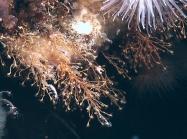
| Introduction | | Search taxa | | Taxon tree | | Taxon match | | Checklist | | Literature | | Stats | | Photogallery | | OBIS Vocab | | Log in |
CaRMS taxon detailsGarveia Wright, 1859
117018 (urn:lsid:marinespecies.org:taxname:117018)
accepted
Genus
marine,
Wright, T.S. (1859). Observations on British zoophytes. <em>The Edinburgh new philosophical journal.</em> 10:105-114, plates 8-9., available online at https://www.biodiversitylibrary.org/page/25486569
page(s): 109 [details]
Schuchert, P. (2024). World Hydrozoa Database. Garveia Wright, 1859. Accessed through: Nozères, C., Kennedy, M.K. (Eds.) (2024) Canadian Register of Marine Species at: https://www.marinespecies.org/carms/aphia.php?p=taxdetails&id=117018 on 2024-04-19
Nozères, C., Kennedy, M.K. (Eds.) (2024). Canadian Register of Marine Species. Garveia Wright, 1859. Accessed at: https://marinespecies.org/carms/aphia.php?p=taxdetails&id=117018 on 2024-04-19
Date action by 2006-09-12 06:54:36Z changed Martinez, Olga
original description
Wright, T.S. (1859). Observations on British zoophytes. <em>The Edinburgh new philosophical journal.</em> 10:105-114, plates 8-9., available online at https://www.biodiversitylibrary.org/page/25486569
page(s): 109 [details] context source (Hexacorallia) Fautin, Daphne G. (2013). Hexacorallians of the World. (look up in IMIS) [details] basis of record van der Land, J.; Vervoort, W.; Cairns, S.D.; Schuchert, P. (2001). Hydrozoa, <B><I>in</I></B>: Costello, M.J. <i>et al.</i> (Ed.) (2001). <i>European register of marine species: a check-list of the marine species in Europe and a bibliography of guides to their identification. Collection Patrimoines Naturels,</i> 50: pp. 112-120 (look up in IMIS) [details] additional source Neave, Sheffield Airey. (1939-1996). Nomenclator Zoologicus vol. 1-10 Online. <em>[Online Nomenclator Zoologicus at Checklistbank. Ubio link has gone].</em> , available online at https://www.checklistbank.org/dataset/126539/about [details] additional source Hayward, P.J. & J.S. Ryland (Eds.). (1990). The marine fauna of the British Isles and North-West Europe: 1. Introduction and protozoans to arthropods. <em>Clarendon Press: Oxford, UK.</em> 627 pp. (look up in IMIS) [details] Available for editors additional source Cairns, S.D., L. Gershwin, F.J. Brook, P. Pugh, E.W. Dawson, O.V.; Ocaña, W. Vervoort, G. Williams, J.E. Watson, D.M. Opresko, P. Schuchert, P.M. Hine, D.P. Gordon, H.I. Campbell, A.J. Wright, J.A.Sánchez & D.G. Fautin. (2009). Phylum Cnidaria: corals, medusae, hydroids, myxozoans. <em>in: Gordon, D.P. (Ed.) (2009). New Zealand inventory of biodiversity: 1. Kingdom Animalia: Radiata, Lophotrochozoa, Deuterostomia.</em> pp. 59-101., available online at https://repository.si.edu/handle/10088/8431 [details] Available for editors redescription Schuchert, P. (2007). The European athecate hydroids and their medusae (Hydrozoa, Cnidaria): Filifera part 2. <em>Revue suisse de Zoologie.</em> 114: 195-396., available online at https://www.biodiversitylibrary.org/page/41281106 page(s): 250 [details]  Present Present  Inaccurate Inaccurate  Introduced: alien Introduced: alien  Containing type locality Containing type locality
From editor or global species database
Diagnosis Colonial hydroids with erect, branched stems, monosiphonic or polysiphonic; hydranth fusiform, hypostome dome-shaped or conical, surrounded by one distal whorl of tentacles; pseudohydrothecae covering polyp base but not sheathing tentacles; gonophores fixed sporosacs, borne on pedicels on hydrocauli or on hydrorhiza. [details]
|
